"If we succumb, it will be with honor, and we will gladly sacrifice our lives whenever we can do something for the benefit of our unfortunate country"
The ship's captain Luis Cadarso died for Spain, in the defeat of Cavite, when he tried to evacuate the "Reina Cristina" his ship burned due to the 81 hits received .
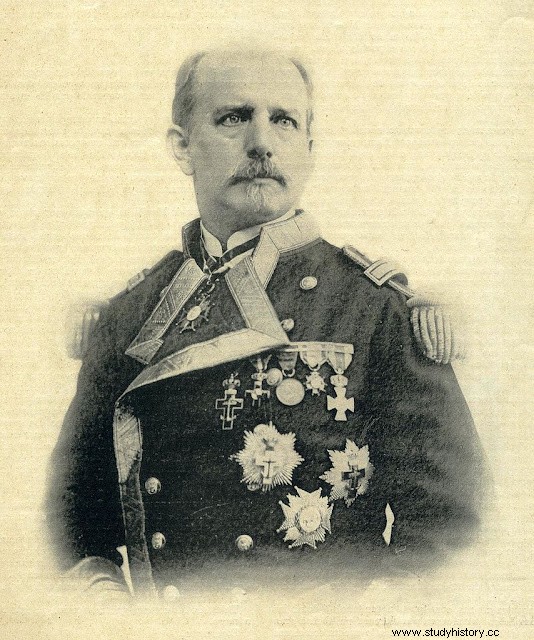 Luis Cadarso y Rey
Luis Cadarso y ReyCadarso Rey, Luis. Noya (Noya, La Coruña, November 24, 1843 - Cavite, Philippines, May 1, 1898) aboard the Reina Cristina cruise ship in Cavite (Philippines).
He was the son of Luis Cadalso and Manuela Rey de Andrade . The Cadarso family enjoyed a good social position; his father, originally from the Navarran town of Viana, had settled in Galicia since his youth, where he practiced law, while his wife's family had strong Galician roots.
From a very young age, Luis's fate seemed being at sea, because in January 1858, when he had just turned 14, he entered the Naval Military School in Marín (Pontevedra) as an applicant. Thanks to a Royal Order he was able to promote to Midshipman 2nd Class in July 1860, and three years later to Midshipman 1st. From then on, it can be said that his rise was meteoric. In July 1865 he was appointed Alférez de Navío, and five years later he obtained the rank of 2nd Lieutenant of the Navy.
A few weeks later, at the age of 26, Cadarso married Demetria de Andrés-Moreno Curiel . The newly married couple settled in Ferrol, the main military base of the Spanish Navy in the north of the peninsula, where their first daughter, whom they named Luisa, was born a year later. A year later, Luis Cadarso played a very important role in the Galician city, when he participated in the suppression of a republican uprising that tried to destabilize the monarchy of Amadeo I. In August of that year, his son, Luis Demetrio, came into the world. but the happiness of the family ended abruptly a year later with the death of Demetria, at the age of 26.
It is likely that Luis Cadarso entrusted the care of his children to some relative (perhaps his brother Manuel and his wife) while he focused all his efforts on channeling his political and military career, which ended up assigning him to the Philippines. It is likely that it was in that country, then a Spanish colony, that he met his second wife, María Natalia Fernández de Cañete Vida, from a Granadan family. The marriage remained in the Philippines for the next decade, as it was there that their four children seem to have been born:Luis, Carmen, Natalia and Emilio.
In January 1878, residing in the Philippines, he was promoted to First Lieutenant, and in April 1887 to Frigate Captain, followed by the rank of Ship Captain in July 1895. All of this allowed that during In his long career, Cadarso actively participated in several fronts and military campaigns, such as the Pacific War. It was precisely in this geographical area that our protagonist held his first political position, as governor of the Caroline Islands (currently part of the Federated State of Micronesia) between 1887 and 1891. He showed a singular zeal and love in the service of his country, as well as remarkable aptitude for command and an energetic spirit framed by military discipline. His service record attests to his « noble and chivalrous spirit. ».
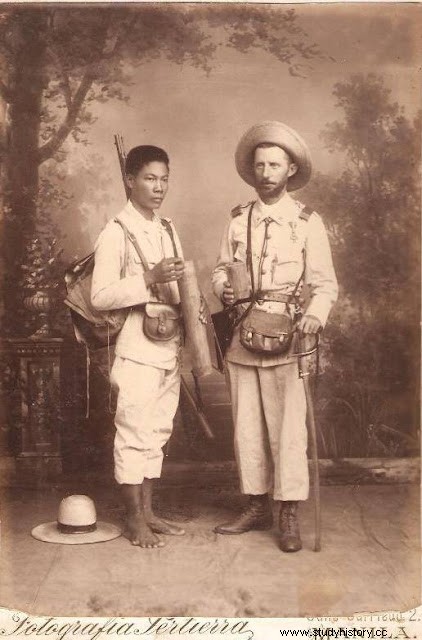 Army Soldiers in the Philippines
Army Soldiers in the PhilippinesCadarso must have been around 50 when he was widowed for the second time, but The undeterred Noyés decided to marry once more around the year 1896, this time with Petronila de Sévigné Huesa, a Navarran woman 28 years his junior.
On February 15, 1898, the Maine, an American warship stationed in Havana Bay, exploded, killing 266 Marines. The United States government accused Spain of having hatched a plan of attack against the Americans, and soon the tension led to a declaration of war. The conflict between Spain and the United States, the first and only time that both nations have maintained a warlike confrontation, was perceived by Spanish intellectuals as a patriotic war in which not only prestige and stability, but also the glory and historical past of the country were at stake. However, those who were well aware of Spain's arms and logistics limitations were under no illusions.
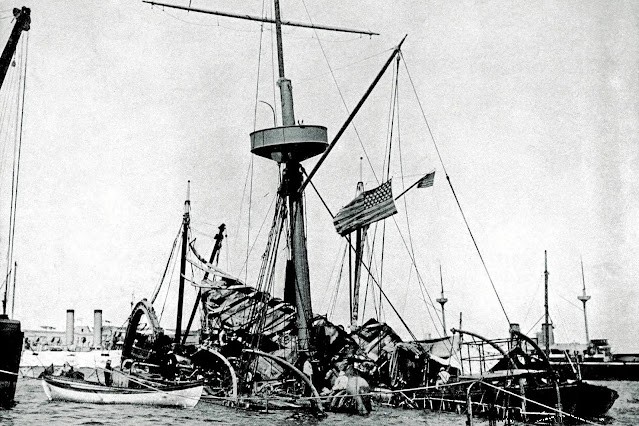 Explosion of the Maine
Explosion of the Maine In April 1898 Luis Cadarso had time to write a few lines to the family of he in Noya before a French mail steamer left for Europe. They would be his last communications with Noya. One of his letters, addressed to his brother Manuel (who, unknown to Luis, had died a month before), read as follows:
« My dear Manolo:I don't know if it will be possible for me to write to you in ahead. Things have reached a point where it is not given to me to know what will become of me. With diplomatic relations broken between our Government and the United States, we await the declaration of war from one moment to the next, and as the American squadron is ready to attack us with six ships (four of them armored), we are ready to fight even when we do not have not a boat with protection. As soon as we know the departure of the American squadron, we will leave, this cruiser and the "Isla de Cuba", "Luzón" and "Castilla" for the immediate port of Subic, where we will act as circumstances require, and we will have to accept such an unequal fight for national decorum. The lack of foresight of our rulers has led us to this annoying situation. However, if we succumb, it will be with honor, and we will gladly sacrifice our lives whenever we can do something for the benefit of our unfortunate country. Poor Nila [her third wife, Petronila], inconsolable, and I find myself having to deposit her in the Santa Isabel school, where Natalia and Carmen [her daughters from her second marriage] spent some time. ]. Your brother wishes you restoration of sight and good health, sending you a loving hug. Luis. Manila 4-21-98 .»
Cadarso was left in command of the Reina Cristina, which belonged to the squadron led by Admiral Patricio Montojo, which had traveled to the Philippines to confront the enemy from Hong Kong. The combatants positioned themselves on April 30 in Cavite Bay, in front of the city of Manila, but it was not until the morning of May 1 that the first shots and detonations were heard. The Americans, who fired up to nine times more projectiles than the Spanish ships thanks to their rapid-firing guns, managed to get Montojo to launch with their flagships Reina Cristina and Don Juan de Austria armed with torpedo tubes to torpedo the flagship of the enemy Dewey. However, a hail of American shells stopped the Spanish attack, severely damaging Montojo's squad, and forcing a retreat towards the Spanish line under American fire. As a result, the two Spanish cruisers Reina Cristina and Castilla were set on fire, while Ulloa and Marqués del Duero suffered considerable damage. In the chaos that accompanied the situation, an enemy grenade fell on the Reina Cristina, hitting Luis Cadarso, who died instantly. His ship was half sunk and unusable.
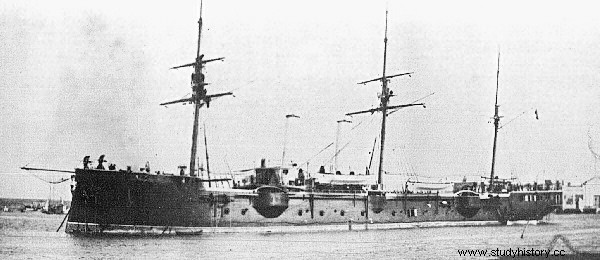 Queen Cristina ship
Queen Cristina shipThe battle of Cavite left around 60 Spanish dead. Montojo, who managed to survive despite being hit in the leg, was prosecuted and expelled from the Navy for having abandoned his squad before the combat was over, but was later reinstated in the reserve; he died in 1917. Meanwhile, the war against the United States lasted several months, taking place mainly in the Caribbean. The Peace of Paris ended up confirming the American victory, and Spain was forced to give up its last historical colonies:Puerto Rico, Guam, Cuba and the Philippines were immediately occupied by the United States. In parallel, several Spanish colonies in the Pacific (including the Carolinas Islands, that archipelago that Luis Cadarso had once governed) were sold to the German Empire for 25 million pesetas.
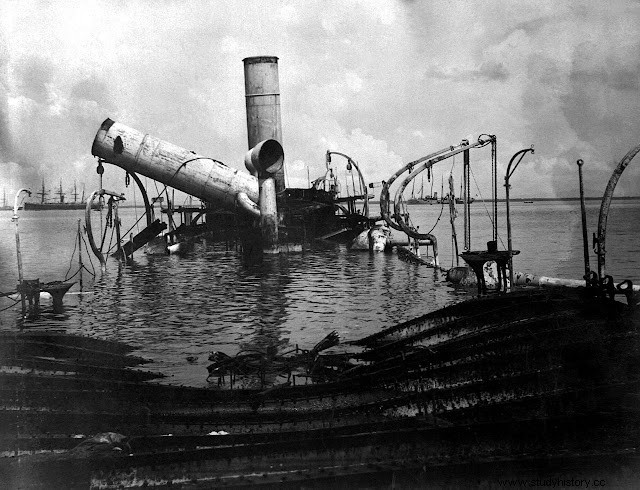 Queen Cristina after the battle
Queen Cristina after the battle Given his sacrifice and heroic death, the figure of Luis Cadarso was praised throughout Spain. For the great courage shown during the battle of Cavite, in which he lost his life, he was posthumously promoted to Admiral. He has a monument dedicated to his memory in his hometown, he is mentioned in the monument to the Heroes of Cavite and Santiago de Cuba in Cartagena and streets in La Coruña, Madrid and Valencia bear his name.
On the other hand, two Navy ships were named in his honor, the Bustamante Class destroyer Cadarso (C) and the Lazaga Class patrol vessel Cadarso (P-03).
